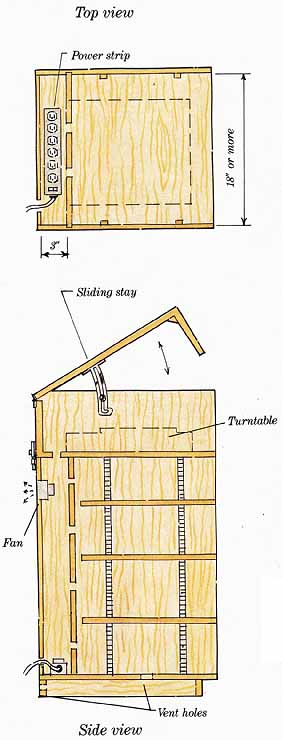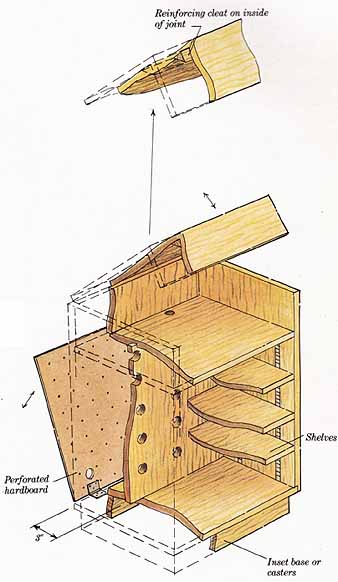Cabinets designed to house electronic entertainment equipment should be as attractive as they are functional Fine craftsmanship and 4 materials will ensure both.
A good design incorporates features that make equipment accessible such as bifold doors, a slide-out shelf, slotted shelf standards with clips, drawers, and cabinet doors. In addition, here are some other ideas to help you create a special piece of furniture.
Flip-up top
The top of a 3- to 4-foot tall cabinet makes a convenient place to locate a record player. A flip-up top on the cabinet hides the turntable when it is not in use and protects it from dust and accidental damage.
To build this feature into your cabinet, first measure your turntable. Plan an appropriately sized cavity to accommodate your unit. (If you foresee changing your equipment in the near future, allow some extra space.)
Extend the side panels of the cabinet so that they form the sides of the cavity. When working out the height, include the thickness of the shelf and top cover (usually ¾ inch plus ¾ inch). Cut the back panel ¾-inch shorter than the side panels.
Set in top shelf, extending it to the front, so that the lower front edge of the flip-up top rests on it when in the closed position.
Cut flip-up top out of ¾-inch ply wood. Make top as deep as side panels of cabinet and add a front lip of the proper height. Reinforce joint between top and front with a triangular wood cleat glued on the inside of the joint. Hinge top to back panel of cabinet with a continuous hinge fixed along the outside back. Use 1 locking sliding stay to hold top open, or 2 friction-type sliding stays, 1 at each side of the top assembly.
It is recommended that you build this project with hardwood-veneered plywood and use standard finish carpentry techniques to finish all ex posed edges and joints.
Double-walled back
To hide the mass of wires that coils and tangles behind electronic equipment, build a double wall to act as the back of the cabinet.
Cut the inner wall from a sturdy material such as 1/2-inch plywood or particleboard. Drill a pattern of 1¼-inch holes in this sheet, making at least 2 holes for each shelf to be installed in the cabinet. Fix this wall into position 3 inches in front of where the second wall will be attached (see illustration opposite).
Cut a second panel (the outer back wall) from lighter material such as perforated hardboard or 1/4-inch ply wood. Mount this panel at the back of the cabinet, hinging it at the bottom and securing it at the top with 1 or 2 sliding-bolt latches. You can open this panel to route and arrange the cords and wires leading to the equipment in the cabinet.
The 3-inch space between the walls allows you to install a multiple-outlet strip, so that you can power all the equipment in the cabinet from 1 incoming cord. To avoid causing a hum in the sound system, try to keep power cords separate from signal wires by feeding them through separate holes rather than coiling them around each other.
If you are worried about the equipment overheating, drill some extra 1¼-inch-diameter holes near the top of each panel for convection cooling, or install a cooling fan at the inside top of the outer panel. Place fan so that it draws cooling air through the holes in the inner back panel. Cooling fans are available at electrical supply stores.
If the cabinet is topped by the flip-up turntable bay described above, extend the double-walled cavity only to the bottom of the shelf that supports the turntable. By drilling 1 or 2 holes at the back of the shelf, you can feed the turntable wiring, between the double walls.
General considerations
When designing and outfitting an entertainment center, you should ob serve a few conventions and recommended precautions.
- Video cassettes, audio cassettes, reels of audiotape, and even computer disks can be ruined by magnetic fields. Therefore, store them away from amplifiers, televisions, and speakers, all of which produce magnetic fields.
- Speakers and televisions interact magnetically when placed next to each other. Don’t build a cabinet where the speakers are housed next to the TV, unless the TV and the speakers are specially designed for this arrangement.
- Keep CDs, DVDs and especially older media formats such as cassettes and records away from heat. If you store them in the equipment cabinet, place them at the bottom (heat rises) or use a fan to cool the cabinet.
- Record (LP) ans LaserDisc collections are heavy. If you plan to store your collection in the cabinet, build an especially sturdy unit.
- Television sets come in a variety of sizes, but electronic equipment, including DVD/CD players and Home-Theater receivers are rarely wider than 19 inches. This is handy to know when designing your cabinet. Most equipment will fit on shelves 16 inches deep; narrower shelves may be adequate for your equipment.


Prev.: Sewing
Center
Next: Ironing-Board
Cabinet
Full guide: How to Plan & Build Bookcases, Cabinets & Shelves
Product
Catalog
